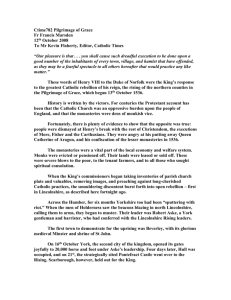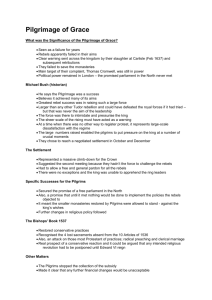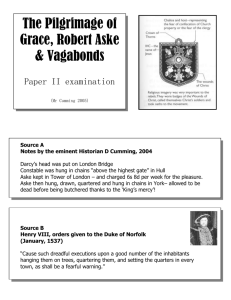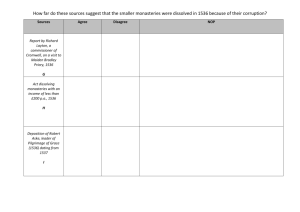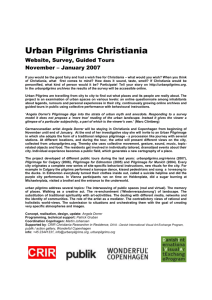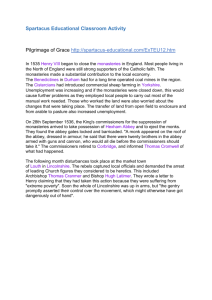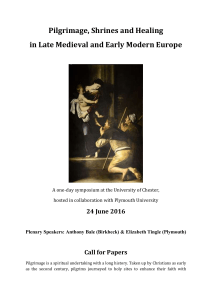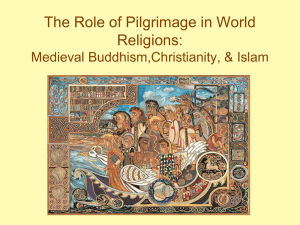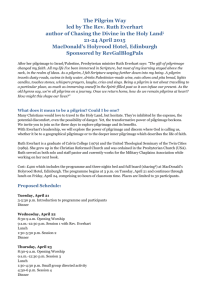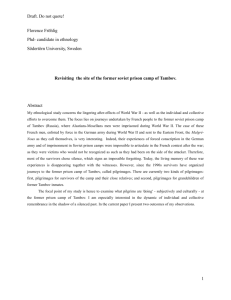Pilgrimage of Grace - Rosie Hawkins
advertisement
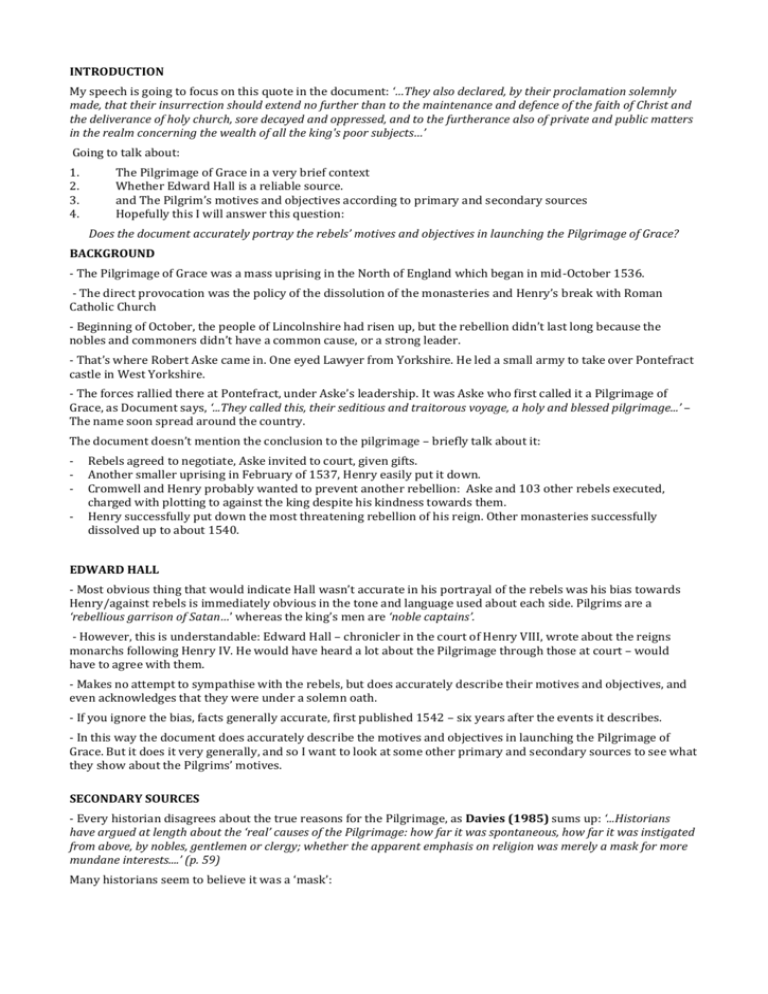
INTRODUCTION My speech is going to focus on this quote in the document: ‘…They also declared, by their proclamation solemnly made, that their insurrection should extend no further than to the maintenance and defence of the faith of Christ and the deliverance of holy church, sore decayed and oppressed, and to the furtherance also of private and public matters in the realm concerning the wealth of all the king's poor subjects…’ Going to talk about: 1. 2. 3. 4. The Pilgrimage of Grace in a very brief context Whether Edward Hall is a reliable source. and The Pilgrim’s motives and objectives according to primary and secondary sources Hopefully this I will answer this question: Does the document accurately portray the rebels’ motives and objectives in launching the Pilgrimage of Grace? BACKGROUND - The Pilgrimage of Grace was a mass uprising in the North of England which began in mid-October 1536. - The direct provocation was the policy of the dissolution of the monasteries and Henry’s break with Roman Catholic Church - Beginning of October, the people of Lincolnshire had risen up, but the rebellion didn’t last long because the nobles and commoners didn’t have a common cause, or a strong leader. - That’s where Robert Aske came in. One eyed Lawyer from Yorkshire. He led a small army to take over Pontefract castle in West Yorkshire. - The forces rallied there at Pontefract, under Aske’s leadership. It was Aske who first called it a Pilgrimage of Grace, as Document says, ‘...They called this, their seditious and traitorous voyage, a holy and blessed pilgrimage...’ – The name soon spread around the country. The document doesn’t mention the conclusion to the pilgrimage – briefly talk about it: - Rebels agreed to negotiate, Aske invited to court, given gifts. Another smaller uprising in February of 1537, Henry easily put it down. Cromwell and Henry probably wanted to prevent another rebellion: Aske and 103 other rebels executed, charged with plotting to against the king despite his kindness towards them. Henry successfully put down the most threatening rebellion of his reign. Other monasteries successfully dissolved up to about 1540. EDWARD HALL - Most obvious thing that would indicate Hall wasn’t accurate in his portrayal of the rebels was his bias towards Henry/against rebels is immediately obvious in the tone and language used about each side. Pilgrims are a ‘rebellious garrison of Satan…’ whereas the king’s men are ‘noble captains’. - However, this is understandable: Edward Hall – chronicler in the court of Henry VIII, wrote about the reigns monarchs following Henry IV. He would have heard a lot about the Pilgrimage through those at court – would have to agree with them. - Makes no attempt to sympathise with the rebels, but does accurately describe their motives and objectives, and even acknowledges that they were under a solemn oath. - If you ignore the bias, facts generally accurate, first published 1542 – six years after the events it describes. - In this way the document does accurately describe the motives and objectives in launching the Pilgrimage of Grace. But it does it very generally, and so I want to look at some other primary and secondary sources to see what they show about the Pilgrims’ motives. SECONDARY SOURCES - Every historian disagrees about the true reasons for the Pilgrimage, as Davies (1985) sums up: ‘...Historians have argued at length about the ‘real’ causes of the Pilgrimage: how far it was spontaneous, how far it was instigated from above, by nobles, gentlemen or clergy; whether the apparent emphasis on religion was merely a mask for more mundane interests....’ (p. 59) Many historians seem to believe it was a ‘mask’: Schevill (1925): ‘…[Rebellion occurred] in the backward counties of the north, where attachment to tradition of particularly strong…’ (p.160) Trevelyan (1964): defending feudal power of families in the north near border with Scotland– Nevilles and Percies. Elton (1958): Blames government’s attempt to control the north, anger over sheep farming and enclosure, rumours that the king would have all the gold in the country and no one would be allowed to eat pork or white bread without a licence (almost everything except religious reform) In fact, all these are true reasons. However, as Moorhouse (2002) says: ‘...The many repercussions of Henry’s breach with the papacy, his attack on the Roman Church’s traditions, its wealth, its liturgies and beliefs, its monastic and other social structures, was the thing common to all the uprisings...’ (p.101) - Only Moorhouse and Davies acknowledge that the Pilgrimage of grace was a result of a combination of religious and secular grievances. I believe this is partly due to the lesser role of religion in our society in recent years. Historians seem to have underestimated the influence of Catholicism in English people’s lives at the time. - Pilgrims were obviously motivated by religion. They all marched behind religious banners as Hall says, and happily wore the badge of the five wounds of Christ, which they wouldn’t do if their motivations were merely secular. PRIMARY SOURCES - The best primary source I can use to show the rebels’ perspective is that of Robert Aske, their leader. He and other rebel leaders, drew up the ‘24 Articles’, which was a list of demands given to the king. He also wrote the Pilgrims’ Oath, which was taught to all of the rebels. The oath begins: The Pilgrim’s Oath Ye shall not enter into this our Pilgrimage of Grace For the commonwealth, but only for the love that ye do bear unto Almighty God his faith, and to Holy Church militant and the maintenance thereof; - It goes on to mention the religious and some political objectives. 1. ‘…the preservation of the King’s person and his issue…’ 2. ‘…[to] expel all … evil councillors…’ 3. ‘…The restitution (restoration) of the Church…’ 4. ‘…The suppression of these heretics and their opinions…’ These are all reflected in the 24 Articles, which were sent to the king. The 24 Articles describe the wishes of the Pilgrim leaders in more detail, and include even more secular and random demands. Fall into three categories – exactly the categories which the document states: 1. 2. 3. Religious Public Private Religious (6) That the suppressed monasteries should be restored to their former state; - This was a huge grievance, not just because the monasteries represented the religious order that was being destroyed. In the north they contributed a lot to daily life. Landlords of many tenants, they gave a substantial amount of their annual income to providing charity and accommodation to the poor. (5) That the Princess Mary should be declared legitimate; Papal Authority should be re-established; heretical books should be suppressed, and heretics punished according to law; - All in reaction to Henry’s split with the Roman Catholic Church in 1533. This is what historians see as clinging to old traditions. However, knowing the role that monasteries and religion played in northerners’ lives. Prince Edward not born at this stage, so the king had no legitimate heirs. Public - Getting rid of Cromwell and his policies In all his actions, Cromwell was attempting to make money for the king and strengthen the government’s control. However, people of the north thought he was trying to wreck their system and take over their governance. He suggested the dissolution of the monasteries to the king, and he got involved in local courts and matters of justice. According to Elton, they believed the king was on their side, but he was being led astray by evil councillors. The appears in both the oath and the articles, which ask that: (9) Lord Cromwell, the vicar-general, Lord Audley, the chancellor, and Rich, the attorney-general, should be removed from the Council; Many people were angry that people of lowly birth had risen to the ranks of king’s advisors. They felt only people of noble blood should run the country so they disliked Cromwell, who was the son of a blacksmith. Private - Statute of Uses - Government Interference in Northern Life was a main concern for nobles who joined the pilgrimage. (4) That some Acts of the late Parliament, which were too grievous to the people, should be repealed; Statute of Uses 1535: - Cromwell - The host led by the Percy family was mainly against the Statute of Uses. People of the north had made loopholes in the laws about inheritance, which meant that the king was losing money. When Cromwell changed the laws in 1535 there were no loopholes, which infuriated landowners in the North: These documents come straight from the Pilgrims; most accurately demonstrate their motives and objectives, which in turn are accurately represented in the document. Conclusion: In my research, found that: Though biased, Hall is a surprisingly reliable source for this subject The document is more accurate than some secondary sources. It states the reasons for the Pilgrimage, though it doesn’t go into detail. Overall, there is still debate over the Pilgrims’ reasons, but I believe most or all of the pilgrims were genuinely concerned about religious change. Yes. If you get past Hall’s tone and language, the document accurately portrays the facts and the Pilgrims’ motives and objectives.
